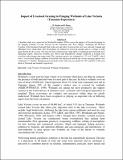| dc.contributor.author | Maskini, M | |
| dc.contributor.author | Hongo, H | |
| dc.date.accessioned | 2015-11-10T11:17:03Z | |
| dc.date.available | 2015-11-10T11:17:03Z | |
| dc.date.issued | 2002 | |
| dc.identifier.citation | Impact of Livestock Grazing to Fringing Wetlands of Lake Victoria (Tanzania Experience) M. Maskini and H. Hongo Wetland Management Component P.O.Box 11045, Mwanza-Tanzania | en_US |
| dc.identifier.uri | http://hdl.handle.net/11671/759 | |
| dc.description.abstract | A baseline study was carried out in October/November 1999 to assess the impacts of Livestock grazing on
the fringing wetlands of Lake Victoria on the Tanzanian side. Two villages bordering the Western
Corridor of the Serengeti National Park in the east and Lake Victoria in the west were selected. Lamadi and
Mbalageti rivers drain them. The flood plains are utilized for livestock grazing and as a refuge of wild
game during the dry season. The area has been experiencing a high influx of immigrant pastoral herds from
Shinyanga region, which has resulted, into serious land degradations. Range conditions at Lamadi were
rated fair with retrogressing range trend. The carrying capacity was estimated at 3.57 to 6.75 ha/LU, which
were 5 overstocked. Range condition at Nyatwali was rated good and the dry season carrying capacity was
estimated at 1.5 ha/LU. Immigrant pastoral herds in the study area accounted for 79% and 82% of the total
herds at Nyatwali and Lamadi, respectively. | en_US |
| dc.language.iso | en | en_US |
| dc.publisher | Lake Victoria Environmental Management Project (LVEMP) | en_US |
| dc.subject | Lake Victoria | en_US |
| dc.subject | Overgrazing | en_US |
| dc.subject | Wetlands | en_US |
| dc.subject | Degradation | en_US |
| dc.title | Impact of Livestock Grazing to Fringing Wetlands of Lake Victoria (Tanzania Experience) | en_US |
| dc.type | Article | en_US |

